by Terry Russell
The Quiet Explosion
 |
Indeed, as Heller's life was saved that day by a ringing telephone, he also had no notion that he had been witness to the birth of an obscure little watch that would someday take on the legendary stature capable of defining this venerable old company. Though he did not know it then, these were the years of the Portuguese.
Small Remittances
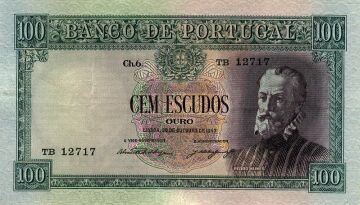 |
With such insignificant sales, Heller's primary interest in this oversized oddity of a wristwatch would have most likely been liquidating old movement inventory and collecting payments due from those two now-famous Portuguese watch dealers, Rodriguez and Teixeira.
Someone Ordered What?
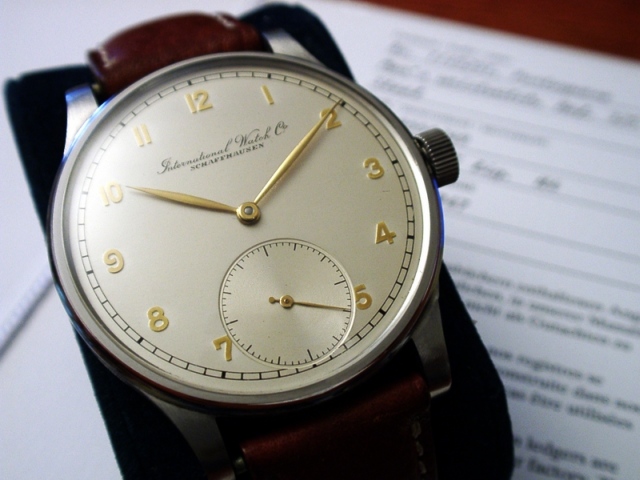 |
Out of hundreds of thousands of watches, a mere 669 Portugueses scattered over 43-years would go on to become an icon within the industry that produced them.
| By 1946, 80% of all known Portugueses had been produced, making the period from 1944 through the end of that year the high point in sales volume. The last 20% would trickle out over the next 35 years. |
Back to the Future
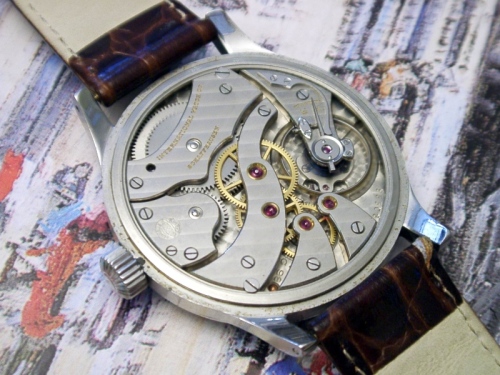 |
None of these however, in and of themselves, would take on the mythical proportions of the Portuguese, and none would ever be as rare. By the time IWC's 125th Anniversary would roll around in 1993, it would be the Portuguese that would be exhumed in celebration of the often tenuous history of this remarkable old manufactory.
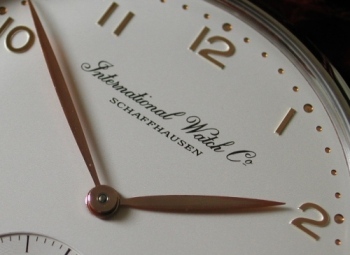 |
Though it hardly seems possible, 2003 marks the 10th Anniversary of the Jubilee Portuguese Uhr and my how time has flown. Though its release feels like only a short while ago, it was all but sold out by the time Internet watch communities started developing, and once discovered, it quickly became one of the "Holy Grail" watches for many collectors. These ten years later its desirability has of course only grown.
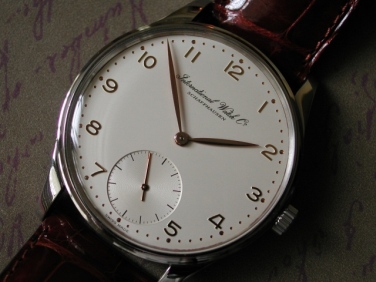 |
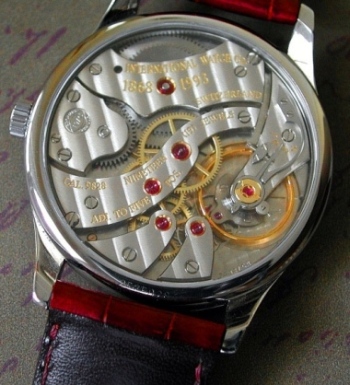 |
The release of the Jubilee in 1993 was not simply a copy, but a delayed continuation of the previous Cal 982 models. To assure its authenticity, IWC utilized original tooling wherever possible and maintained the integrity of all original design and dimensional characteristics.
Offered individually in three metals and in a limited number of boxed sets, the Jubilee was instantly sought after. There were 1000 produced in stainless steel, 500 in rose gold, and 250 in platinum.
Sapphire glass backs gave the first factory-installed view of the Cal 982 pocketwatch movement, transformed by its special Jubilee engraving into the Cal 9828.
The single Jubilees came in a special wooden casket with a descriptive plaque and hardbound instruction booklet. Though not included with the watch, there was at least one other large-format folio commemorating the 125th Anniversary. It covered not only the Jubilee, but the introduction of the IL Destriero Scafusia, as well as an interesting smattering of company anecdotes and history. The sets of Jubilees came packaged in special boxes containing one each of the three metals, some of which were split up among several buyers, explaining in part why low numbered models still occasionally surface without boxes and papers.
Once this watch and its provenance became known to more and more collectors, accounts from numerous individuals surfaced about their mad pursuits to track these down.
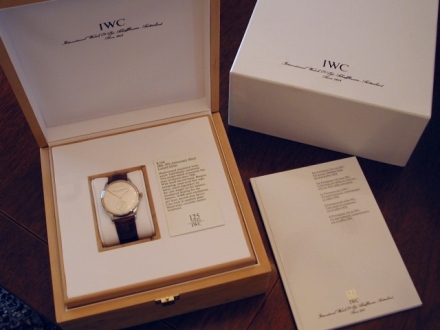
|
Early Internet discussions actually focused on whether or not the Jubilee was wearable and even some who owned it felt it better collected than worn. As watches have grown in size by more than 25% over the last ten years, the Jubilee today seems hardly that large at all.
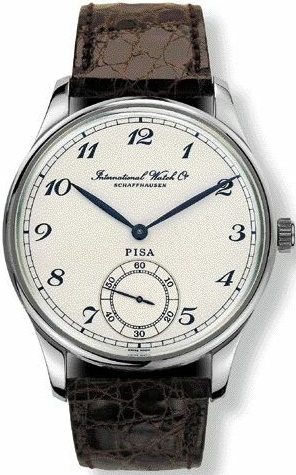 |
Several years after the Jubilee was introduced, IWC produced what might possibly be the last of the Portugueses from the original lineage. Itself a commemorative watch celebrating 50 years of business for the dealer Orologeria Pisa in Milan, Italy, the "Pisa" Portuguese was released in 1996.
Essentially identical in all respects to the previous Portugueses, the Pisa differed from the Jubilee only in dial appearance, featuring breguet numerals and blued hands found on some of the earlier vintage models. While the Pisa would not have the special movement engraving found on the Jubilee, it would remain a true Portuguese in all respects.
At an issue of only 50-pieces, the Pisa has become as hard to find as the early originals, though much easier to authenticate.
Dial variations were almost as numerous as the watches themselves - relatively speaking of course. The Portuguese was possibly IWC's only watch model ever that was dialed from whatever might have been handy when orders were received.
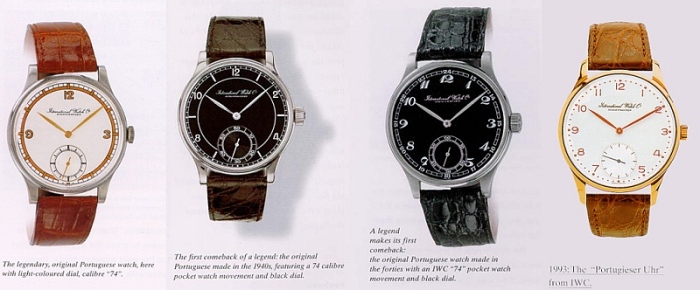
plate 5 Various Portuguese Dials
Defining Moments
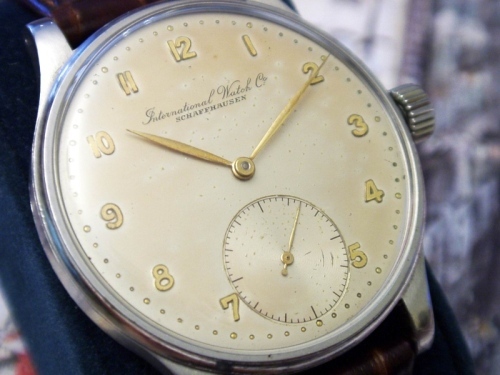 |
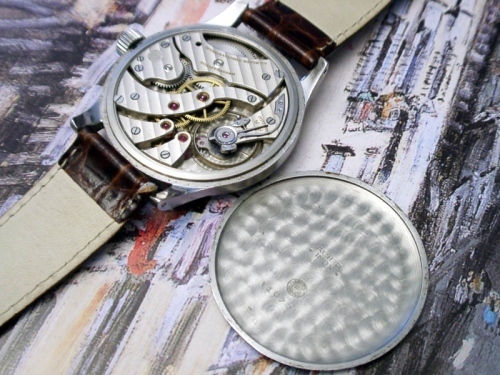 |
Indeed. The Portuguese. The most powerful man in the world of Swiss watches has almost everything, but he hasn't one single model analogous to this mystical and storied old watch from Schaffhausen.
Terry Russell
Copyright 2003
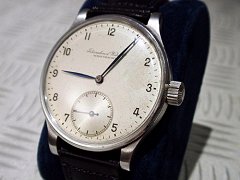 |
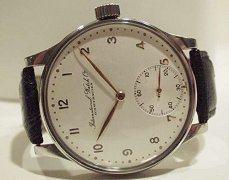 |
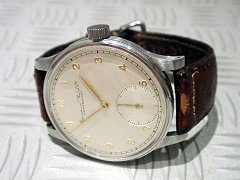 |

| Acknowledgements I would like to thank Tornyai László of Hungary for the generous use of his photographs. He is an avid IWC collector who is fortunate enough to own four vintage Portugueses, all containing the Cal98. I would also like to thank Michael Friedberg not only for his photo contributions but for his review and invaluable edits of this article, and his guidance over the years in support of my interest in IWC. In any capacity, he is an asset to the subject at hand. |
Photo Credits plate 1: provided and used by permission of Tornyai László plate 2: provided and used by permission of Tornyai László plate 3: photo by Terry Russell plate 4: used by permission of Michael Friedberg / IWC plate 5: used by permission of Michael Friedberg / IWC plate 6: provided and used by permission of Tornyai László plate 7: provided and used by permission of Tornyai László plate 8: provided and used by permission of Tornyai László plate 9: provided and used by permission of Michael Friedberg plate 10: provided and used by permission of Tornyai László plate 11: provided and used by permission of Michael Friedberg - all other watch photos by Terry Russell - all remaining photos used under "doctrine of fair use" |